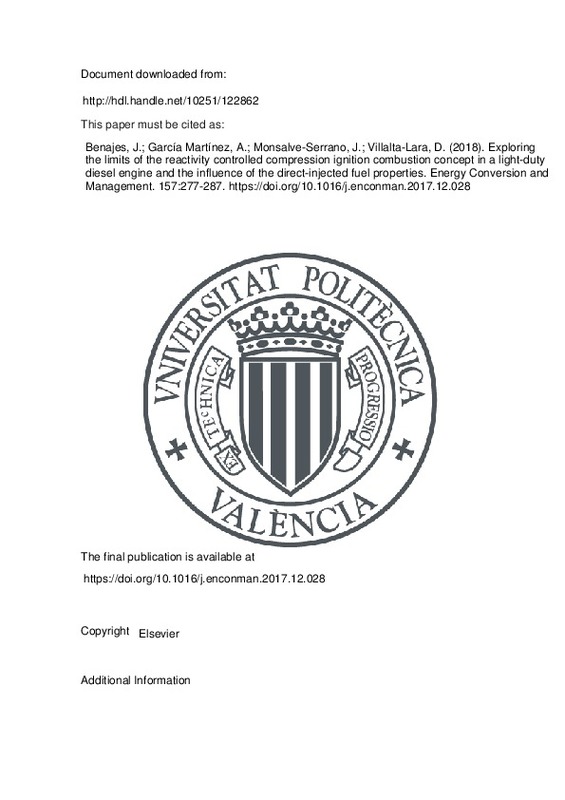JavaScript is disabled for your browser. Some features of this site may not work without it.
Buscar en RiuNet
Listar
Mi cuenta
Estadísticas
Ayuda RiuNet
Admin. UPV
Exploring the limits of the reactivity controlled compression ignition combustion concept in a light-duty diesel engine and the influence of the direct-injected fuel properties
Mostrar el registro sencillo del ítem
Ficheros en el ítem
| dc.contributor.author | Benajes, Jesús
|
es_ES |
| dc.contributor.author | García Martínez, Antonio
|
es_ES |
| dc.contributor.author | Monsalve-Serrano, Javier
|
es_ES |
| dc.contributor.author | Villalta-Lara, David
|
es_ES |
| dc.date.accessioned | 2019-06-28T20:02:53Z | |
| dc.date.available | 2019-06-28T20:02:53Z | |
| dc.date.issued | 2018 | es_ES |
| dc.identifier.issn | 0196-8904 | es_ES |
| dc.identifier.uri | http://hdl.handle.net/10251/122862 | |
| dc.description.abstract | [EN] This experimental work investigates the operational limits of the reactivity controlled compression ignition combustion concept in a light-duty single-cylinder diesel engine using the stock compression ratio (17.1:1) with specific constraints. In addition, the effects of using different direct-injected fuels on engine-out emissions and performance are analyzed. First, an engine mapping was performed using diesel and gasoline as direct-injected and port-injected fuels, respectively. The operational limits of the reactivity controlled compression ignition concept have been found to be confined in the region defined from 2 to 5 bar indicated mean effective pressure at 1000 rev/min and from 4 to 8 bar indicated mean effective pressure at 3000 rev/min. In that portion of the map, nitrogen oxides and smoke emissions were below 0.4 g/kW h and 0.1 filter smoke number simultaneously, and the engine mechanical limits were respected. Later, the effects of the direct-injected fuel properties have been evaluated at the points that define the frontiers of maximum and minimum engine load in the baseline engine map (diesel/gasoline). To do this, three additional fuels based on diesel-gasoline mixings at different ratios (90%-10%, 70%-30% and 50%-50%), also known as dieseline, were used as direct-injected fuel instead of 100% diesel. To isolate the effects of each direct-injected fuel, the same engine settings were used for the comparison. The results show that, as the reactivity gradient between the high and low reactivity fuel diminishes, the sequential autoignition achieved in reactivity controlled compression ignition due to local combustion reactions switches to a more kinetically controlled homogeneous charge compression ignition-like combustion process. Finally, all the fuels were found to be capable of operating inside the emissions restrictions imposed by doing little modifications on the baseline calibration. However, no clear potential was found versus using 100% diesel as high-reactivity fuel. | es_ES |
| dc.description.sponsorship | The authors gratefully acknowledge General Motors Global Research & Development for providing the engine used in this investigation. The authors also acknowledge FEDER and Spanish Ministerio de Economia y Competitividad for partially supporting this research through HiReCo project (TRA2014-58870-R). The author J. Monsalve-Serrano acknowledges the financial support from the Universitat Politecnica de Valencia under the grant "Ayudas Para la Contratacion de Doctores para el Acceso al Sistema Espanol de Ciencia, Tecnologia e Innovacion". | es_ES |
| dc.language | Inglés | es_ES |
| dc.publisher | Elsevier | es_ES |
| dc.relation.ispartof | Energy Conversion and Management | es_ES |
| dc.rights | Reconocimiento - No comercial - Sin obra derivada (by-nc-nd) | es_ES |
| dc.subject | Reactivity controlled compression ignition | es_ES |
| dc.subject | Dual-fuel combustion | es_ES |
| dc.subject | Engine map | es_ES |
| dc.subject | Efficiency | es_ES |
| dc.subject | Dieseline | es_ES |
| dc.subject.classification | MAQUINAS Y MOTORES TERMICOS | es_ES |
| dc.title | Exploring the limits of the reactivity controlled compression ignition combustion concept in a light-duty diesel engine and the influence of the direct-injected fuel properties | es_ES |
| dc.type | Artículo | es_ES |
| dc.identifier.doi | 10.1016/j.enconman.2017.12.028 | es_ES |
| dc.relation.projectID | info:eu-repo/grantAgreement/MINECO//TRA2014-58870-R/ES/REDUCCION DE LAS EMISIONES DE CO2 EN VEHICULOS PARA TRANSPORTE USANDO COMBUSTION DUAL NATURAL GAS-DIESEL/ | es_ES |
| dc.rights.accessRights | Abierto | es_ES |
| dc.contributor.affiliation | Universitat Politècnica de València. Departamento de Máquinas y Motores Térmicos - Departament de Màquines i Motors Tèrmics | es_ES |
| dc.description.bibliographicCitation | Benajes, J.; García Martínez, A.; Monsalve-Serrano, J.; Villalta-Lara, D. (2018). Exploring the limits of the reactivity controlled compression ignition combustion concept in a light-duty diesel engine and the influence of the direct-injected fuel properties. Energy Conversion and Management. 157:277-287. https://doi.org/10.1016/j.enconman.2017.12.028 | es_ES |
| dc.description.accrualMethod | S | es_ES |
| dc.relation.publisherversion | https://doi.org/10.1016/j.enconman.2017.12.028 | es_ES |
| dc.description.upvformatpinicio | 277 | es_ES |
| dc.description.upvformatpfin | 287 | es_ES |
| dc.type.version | info:eu-repo/semantics/publishedVersion | es_ES |
| dc.description.volume | 157 | es_ES |
| dc.relation.pasarela | S\348860 | es_ES |
| dc.contributor.funder | Ministerio de Economía y Competitividad | es_ES |







![[Cerrado]](/themes/UPV/images/candado.png)

